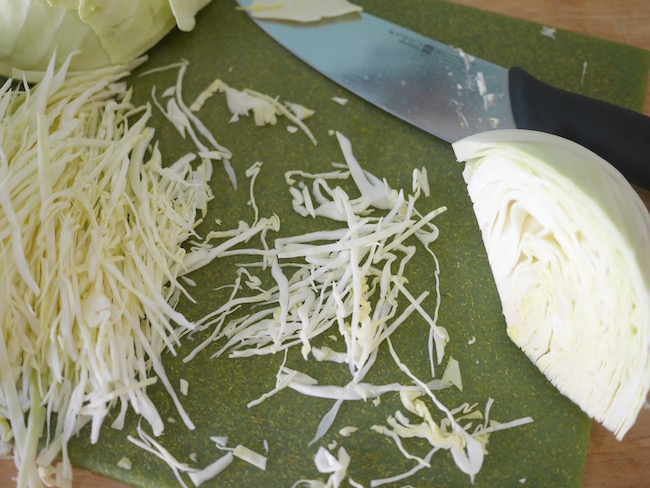Dry, tough storage cabbage that doesn't easily release a juicy brine
Let’s talk about fermenting storage cabbages. Last week I taught a hands-on class. I’d bought each student a beautiful small head of cabbage. Later, that evening during the demonstration portion of the class, I realized that the students would have to make their first ferment with rebellious cabbage.
Here’s the thing: as I stand in front of the impressionable new fermenters, I am often slicing, salting and then massaging a cabbage while talking. (No, I can’t pat my head and rub my belly at the same time but I can talk and build a jar of sauerkraut at the same time.) So it throws me off when I am massaging and telling the good people about brine and the cabbage refuses to give it up. I continue to talk as I am working harder and harder, smiling, trying to make it look effortless.
In this case, they were about to use the cabbages themselves so I stopped and said, “You guys are going to have fun with this cabbage; it’s a tough storage cabbage, you will want to make sure to take your time and slice it thinly.” (Which was a challenge as the venue had provided everyone with boning knives, but that is beside the point.) “The good news is, this is about as hard as making kraut will ever be, so it’s smooth sailing from here.”
Let me digress a moment to share a story about the first time I’d learned that storage cabbages can be a problem for fermenting. The lack of inherent moisture, the thick waxy leaves, all the qualities that keep these cabbages from rotting in storage are exactly what inhibit the fermentation, because what is fermentation if not controlled rot? In the following tale of a small sauerkraut company and the Storage No. 4 cabbage variety this lesson was learned—the hard way.
This small company I speak of operates with the triple bottom line and is exceedingly committed to supporting the local foodshed by using only local ingredients when in season. So when one of the local farmers came to the company with the idea to provide cabbages for a longer season by growing a keeper that was harvested in the fall and capable of surviving storage through the spring it seemed like a win-win situation. The kraut company would have local cabbage in the late winter and early spring for production. The farm would also extend its income stream. Done. Acres and acres were planted. The cabbages did what cabbages do and grew and grew. They were harvested and stored and eventually processed and set in fermenting barrels as needed to keep supplies fresh and abundant. When the first barrels were opened after three weeks, the cabbage had not yet fermented. At first this was strange but can happen so they closed the barrel and allowed more time. Eventually, after waiting for a few months they had to concede that this kraut wasn’t going to be good.
You are most likely to run into these cabbages in grocery stores in February, March, and into April when the winter cabbages are sold and the spring cabbages have not yet matured. It is hard to tell at first glance, and even upon deeper inspection it can be confusing. I admit, when I am out buying cabbage I look for crisp and fresh, not wilted, but I don’t even think about checking the head for signs of being a storage variety cabbage. And while I want you to know all about these varietals, this post is really about what to do when you find yourself with a tough cabbage—you may discover this when you are slicing through extremely dense interiors with thicker, waxier leaves, or later when you are squishing along and not seeing brine.
Tips for a successful ferment with a dry, coarse cabbage:
· Slice as thinly as possible (breaking more cell walls)
· Add salt, mix thoroughly, and allow to sit for a half hour before massaging (will break down the tough leaves and coax out moisture)
· Make a mixed-veggie kraut instead of a plain, naked cabbage kraut (other veggies will bring their juice to the mix and help create enough brine to allow the microbes to do their job)
Favorite veggies for a juicier kraut: Onions, shredded carrots, shredded beets, shredded turnips (these will give you a flavor the most consistent with a plain kraut), and other shredded root veggies. Pictured here is Curtido (recipe in Fermented Vegetables) it is delicious and the many onions create a juicy brine.




